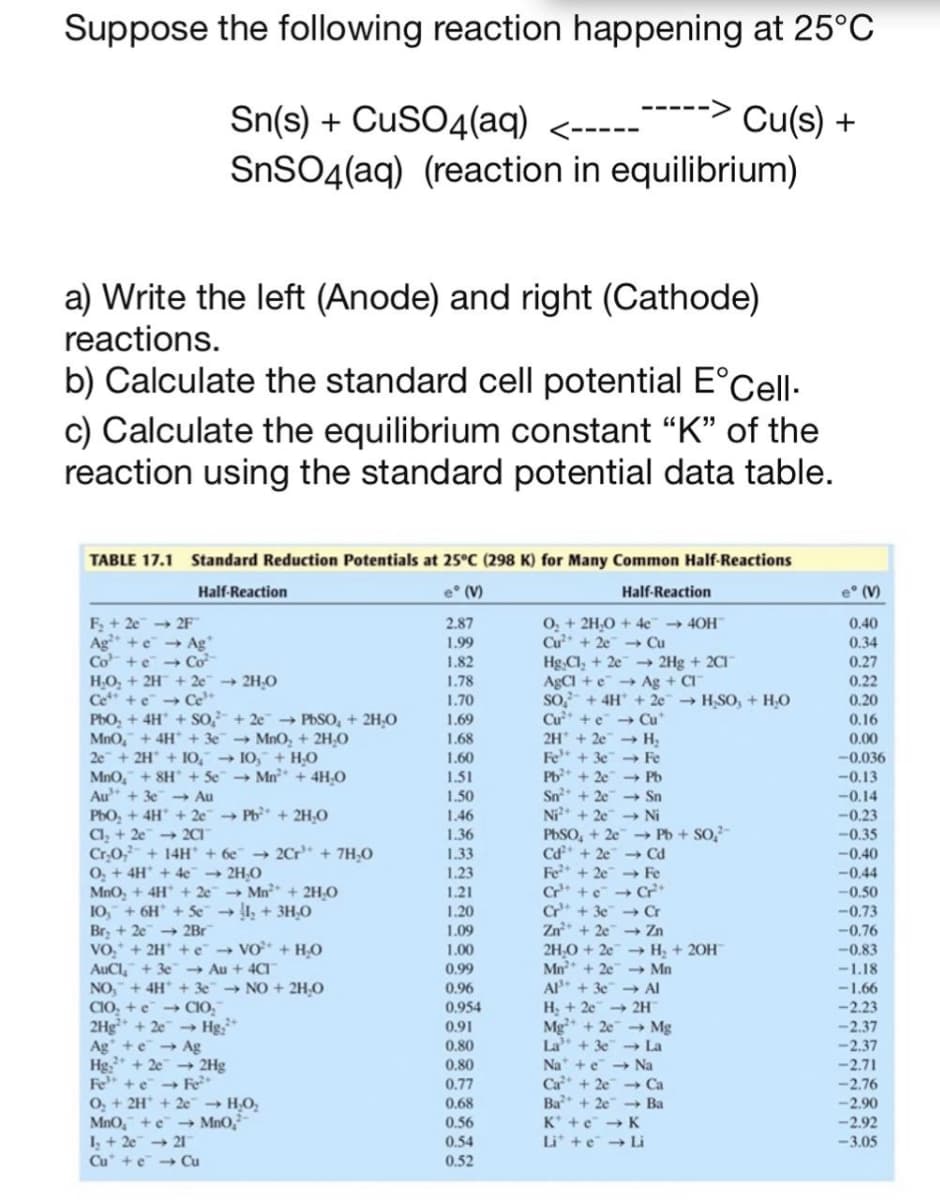Suppose the following reaction happening at 25°C Sn(s) + CuSO4(aq) <-----¯ Cu(s) + SNSO4(aq) (reaction in equilibrium) a) Write the left (Anode) and right (Cathode) reactions. b) Calculate the standard cell potential E°Cell- c) Calculate the equilibrium constant “K" of the reaction using the standard potential data table.
Suppose the following reaction happening at 25°C Sn(s) + CuSO4(aq) <-----¯ Cu(s) + SNSO4(aq) (reaction in equilibrium) a) Write the left (Anode) and right (Cathode) reactions. b) Calculate the standard cell potential E°Cell- c) Calculate the equilibrium constant “K" of the reaction using the standard potential data table.
Chemistry: An Atoms First Approach
2nd Edition
ISBN:9781305079243
Author:Steven S. Zumdahl, Susan A. Zumdahl
Publisher:Steven S. Zumdahl, Susan A. Zumdahl
Chapter17: Electrochemistry
Section: Chapter Questions
Problem 160MP
Related questions
Question

Transcribed Image Text:Suppose the following reaction happening at 25°C
Sn(s) + CuSO4(aq)
SNSO4(aq) (reaction in equilibrium)
Cu(s) +
<-----
a) Write the left (Anode) and right (Cathode)
reactions.
b) Calculate the standard cell potential E°Cell·
c) Calculate the equilibrium constant “K" of the
reaction using the standard potential data table.
TABLE 17.1 Standard Reduction Potentials at 25°C (298 K) for Many Common Half-Reactions
Half-Reaction
e (V)
Half-Reaction
e° (V)
F + 2e 2F
Ag* +e - Ag"
Co +e →Cơ
H,O, + 2H + 2e 2H,0
Ce +e → Ce*
PbO, + 4H + so + 2e PbSO, + 2H,0
MnO, + 4H* + 3e MnO, + 2H,O
2e + 2H + IO, 10, + H,0
MnO, + 8H + Se" → Mn* + 4H,0
Au + 3e -→ Au
PbO, + 4H + 2e Pb* + 2H,O
Ca, + 2e" → 2CI"
Cr0,- + 14H + 6e" → 2Cr“ + 7H,0
O, + 4H + 4e 2H,O
MnO, + 4H + 2e Mn + 2H,O
10, + 6H + Se → I, + 3H,0
Br, + 2e 2Br
-2H +e VO + H,O
2.87
1.99
O, + 2H,0 + 4c → 40H
Cu + 2e Cu
Hg,Cl, + 2e -→ 2Hg + 2CI
AgCI +e Ag + CI
so- + 4H + 2e → H,SO, + H,O
Cu* + e - Cu*
2H + 2e H;
Fe + 3e Fe
Pb* + 2e" -→ Pb
Sn
Ni* + 2e Ni
PbSO, + 2e - Pb + So,-
Cd + 2e -→ Cd
Fe* + 2e Fe
Cr* +e Cr*
Cr + 3e → Cr
Zn* + 2e - Zn
0.40
0.34
1.82
0.27
1.78
0.22
1.70
0.20
1.69
1.68
0.16
0,00
1.60
-0.036
1.51
-0.13
2e Sn
1.50
1.46
1.36
-0.14
-0.23
-0.35
-0.40
1.33
1.23
-0,44
1.21
-0,50
1.20
-0.73
1.09
-0.76
-0.83
VO,
AuCl, + 3e → Au + 4CI
NO, + 4H + 3e NO + 2H,O
CIO, +e → CIO,
2Hg* + 2e Hg,*
Ag +e → Ag
Hg, + 2e 2Hg
Fe +e → Fe*
O, + 2H* + 2e" → H;O;
MnO, +e -→ MnO,
I, + 2e 21
Cu +e Cu
1.00
2H,0 + 2e - H, + 20H
Mn + 2e"- Mn
Al + 3e → Al
H + 2e 2H
Mg + 2e Mg
La + 3e -→ La
Na + e → Na
Ca + 2e -→ Ca
Ba + 2e" - Ba
-1.18
-1.66
0.99
0.96
0.954
-2.23
-2.37
-2.37
-2.71
-2.76
0.91
0,80
0.80
0.77
0.68
-2.90
0.56
K* +e - K
-2.92
0.54
Li +e Li
-3.05
0.52
Expert Solution
This question has been solved!
Explore an expertly crafted, step-by-step solution for a thorough understanding of key concepts.
Step by step
Solved in 4 steps with 5 images

Knowledge Booster
Learn more about
Need a deep-dive on the concept behind this application? Look no further. Learn more about this topic, chemistry and related others by exploring similar questions and additional content below.Recommended textbooks for you

Chemistry: An Atoms First Approach
Chemistry
ISBN:
9781305079243
Author:
Steven S. Zumdahl, Susan A. Zumdahl
Publisher:
Cengage Learning


Chemistry
Chemistry
ISBN:
9781305957404
Author:
Steven S. Zumdahl, Susan A. Zumdahl, Donald J. DeCoste
Publisher:
Cengage Learning

Chemistry: An Atoms First Approach
Chemistry
ISBN:
9781305079243
Author:
Steven S. Zumdahl, Susan A. Zumdahl
Publisher:
Cengage Learning


Chemistry
Chemistry
ISBN:
9781305957404
Author:
Steven S. Zumdahl, Susan A. Zumdahl, Donald J. DeCoste
Publisher:
Cengage Learning

Chemistry: Principles and Practice
Chemistry
ISBN:
9780534420123
Author:
Daniel L. Reger, Scott R. Goode, David W. Ball, Edward Mercer
Publisher:
Cengage Learning

Principles of Modern Chemistry
Chemistry
ISBN:
9781305079113
Author:
David W. Oxtoby, H. Pat Gillis, Laurie J. Butler
Publisher:
Cengage Learning

Chemistry: The Molecular Science
Chemistry
ISBN:
9781285199047
Author:
John W. Moore, Conrad L. Stanitski
Publisher:
Cengage Learning